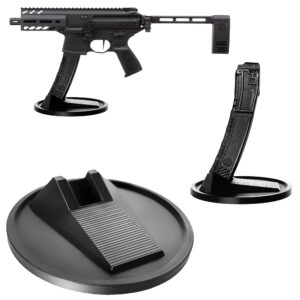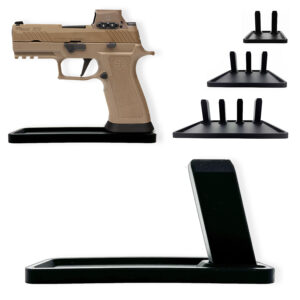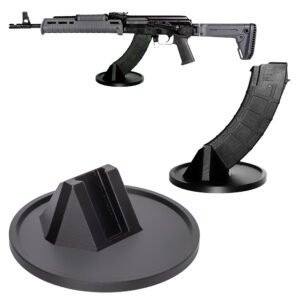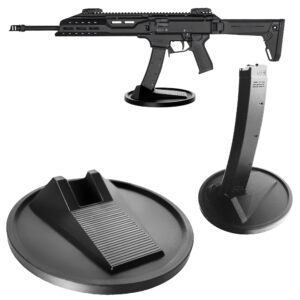
Categories:
The AR-10 is a widely respected and versatile gun in the realm of semi-automatic rifles, known for its substantial firepower and modularity. One of the integral components of its operation is the safety selector, a small but significant switch that plays a crucial role in the gun’s functionality and overall safety. Understanding the safety selector is essential for anyone using or maintaining an AR-10, as it impacts the weapon’s readiness and security.
The safety selector on an AR-10 allows the shooter to toggle between two primary modes: ‘safe’ and ‘fire’. In the ‘safe’ mode, the selector restricts the trigger from moving, which prevents the hammer from being released and thereby inhibits the firing mechanism. This is a critical feature for ensuring that the gun does not discharge unintentionally, which could lead to accidents or injuries.
When the gun is not actively being used, placing it in the ‘safe’ mode is a standard protocol to ensure it will not fire even if the trigger is pulled. This makes it ideal for handling, transporting, and storing the weapon without the constant risk of an accidental discharge.
When the selector is switched to the ‘fire’ mode, it disengages the safety mechanism, enabling the shooter to pull the trigger and discharge the gun. This mode allows the trigger to manipulate the hammer and firing pin, thereby initiating the firing sequence. The transition from ‘safe’ to ‘fire’ is designed to be quick and straightforward, typically achievable through a simple 90-degree rotation of the selector lever, ensuring that the shooter can ready the gun in an instant when the situation demands.
Modern AR-10 safety selectors often feature ambidextrous designs, offering convenience for both right-handed and left-handed shooters. This not only enhances accessibility but also improves the overall handling experience. Some variants offer adjustable throw levers, allowing for a more customized user experience based on personal preference and ergonomic comfort.
Ultimately, the proper use and understanding of the safety selector are foundational to responsible AR-10 ownership. It ensures that the gun can be handled safely when not in use, while still being ready to perform efficiently and effectively when necessary. Knowing how and when to engage the safety selector is a fundamental aspect of gun safety and overall operational proficiency.
In the realm of guns, safety is of paramount importance. Among the critical components that contribute to the safe operation of these weapons is the safety selector. The AR-10, a widely recognized and utilized rifle, incorporates a safety selector that allows the operator to switch between safe and fire modes. Understanding the importance of safety selectors in guns is essential for ensuring the secure handling and operation of these powerful tools.
Safety selectors serve as a fundamental feature for preventing accidental discharges. When the safety selector is engaged in the “safe” position, the gun’s trigger mechanism is blocked, preventing the hammer from striking the firing pin and discharging a round. This mechanical barrier is crucial, especially in situations where the gun is loaded and a round is chambered. The presence of the safety selector ensures that unintentional pressure on the trigger, whether due to human error or environmental factors, does not result in a potentially dangerous discharge.
Moreover, the incorporation of a safety selector aids in fostering responsible gun handling practices. It requires the shooter to consciously and deliberately engage the safety mechanism, thereby promoting mindfulness and attentiveness. Such a practice instills a culture of responsibility and caution among gun users. This is particularly vital for novice shooters who are still developing their proficiency and understanding of gun operation.
By consistently using the safety selector, they cultivate safer handling habits that can significantly reduce the risk of accidental injury.
Additionally, safety selectors are indispensable in various tactical and operational contexts. For law enforcement and military personnel, the ability to quickly and reliably switch between safe and fire modes can be life-saving. During high-stress situations, where quick reflexes are required, the intuitive and accessible design of safety selectors allows for seamless transitions between readying the weapon for use and securing it against unintended firings.
This functionality is equally valuable in civilian defensive scenarios, where the immediate need to switch to a defensive posture can arise suddenly.
In essence, the importance of safety selectors in guns cannot be overstated. They not only serve as a critical safeguard against accidental discharges but also reinforce responsible gun handling practices and provide invaluable operational flexibility. For guns like the AR-10, the safety selector is a key component that enhances overall safety, user accountability, and tactical readiness. Promoting a thorough understanding and consistent use of this component is vital for ensuring the well-being and effectiveness of all gun users.
When it comes to the AR-10 rifle, safety is a paramount concern for any shooter. One of the critical components ensuring this safety is the safety selector. The safety selector is a vital element that allows the user to switch between ‘safe’ and ‘fire’ modes, effectively preventing accidental discharges when the weapon is not in use or authorizing the discharge when required.
Various types of safety selectors are available for the AR-10, each catering to different shooting needs, preferences, and ergonomic demands.
One of the most common types of safety selectors for the AR-10 is the standard mil-spec selector. This is the basic version that comes with many AR-10 rifles straight from the manufacturer. It features a straightforward design with a lever that can be rotated from the ‘safe’ position to the ‘fire’ position. This type of selector is widely used due to its simplicity and reliability.
Another popular type is the ambidextrous safety selector. Unlike the standard mil-spec option, the ambidextrous selector is designed for both left-handed and right-handed shooters. This design significantly enhances the ergonomics and operational efficiency of the rifle, making it convenient for a wider variety of users. It typically features levers on both sides of the receiver, allowing the shooter to engage or disengage the safety without needing to adjust their grip on the rifle.
Enhanced or extended safety selectors are another variant available on the market. These selectors often feature an extended lever to provide a larger surface area for the shooter’s thumb or finger. This can make it easier to operate the safety, especially in high-stress situations or when wearing gloves. Some enhanced models also come with textured surfaces to ensure a positive grip during operation.
Modular safety selectors offer another level of customization. These selectors generally come with interchangeable levers or paddles, allowing the user to configure the selector according to their preferred reach and operating style. The modular design enables shooters to find the best fit for their hand size, finger length, and ergonomic preference, providing a tailored shooting experience.
Combining ease of use, safety, and adaptability, the various types of safety selectors available for the AR-10 ensure that there is an option suitable for every shooter, regardless of their specific needs or shooting conditions.
The safety selector in an AR-10 rifle is a crucial mechanism that allows the shooter to switch between the safe and fire modes, ensuring both gun safety and operational efficiency. Understanding the intricacies of how the safety selector functions provides insights into the balance between user control and mechanical reliability within the gun.
At its core, the safety selector is essentially a lever connected to an internal rotating cam that interacts with the trigger assembly. When the selector is in the ‘safe’ position, which is typically marked by an ‘s’ on the lever, the cam rotates to a position where it blocks the trigger from moving. This interruption occurs because the cam exerts pressure against the trigger, preventing it from engaging the sear—a critical component that releases the hammer to strike the firing pin.
By halting the trigger’s motion, the safety selector effectively prevents the gun from discharging, even if significant pressure is applied to the trigger.
Shifting the selector to the ‘fire’ position, often indicated by an ‘F’, rotates the cam to an unblocking position where it no longer impedes the trigger’s movement. This action allows the trigger to pivot freely, enabling the shooter to engage the sear. When the trigger is pulled, the sear disengages from the hammer, which then snaps forward under spring tension to strike the firing pin, culminating in the ignition of the cartridge.
The precision of this mechanical dance is essential for the gun’s operation, as every component must be finely tuned to function seamlessly.
The materials used in the creation of the safety selector, such as high-grade steel or aluminum alloys, are chosen for their durability and resistance to wear. These materials ensure that the selector maintains its integrity and reliability over numerous cycles of switching between modes. Additionally, the design often incorporates detent springs and bearings that provide tactile feedback to the user, indicating a secure transition between safe and fire positions.
This feedback is not only a safety feature but also an ergonomic enhancement, aiding shooters in operating the rifle with greater confidence and assurance.
In summary, the AR-10 safety selector exemplifies a precision-engineered mechanism essential for gun safety and functionality. Through its rotational cam and interaction with the trigger assembly, it provides a straightforward yet reliable means for shooters to control when the rifle can or cannot discharge, ensuring both operational readiness and user safety.
Installing an AR-10 safety selector is a critical process that ensures your gun operates smoothly and safely. Before beginning the installation, make sure you have all necessary tools and parts, including the AR-10 safety selector, a punch tool set, a small hammer, a flathead screwdriver, and a torque wrench. Ensure the gun is unloaded, with the magazine removed and the chamber checked and cleared.
Safety should be your top priority, and this first step is crucial in preventing accidental discharge.
Start by disassembling the lower receiver. Begin by removing the pistol grip, as the detent spring and safety selector detent are located underneath it. Use the flathead screwdriver to unscrew the pistol grip screw. Carefully remove the grip while keeping an eye on the small detent and spring to prevent them from flying out. Once the grip is off, set it aside along with the detent and spring.
Next, take the punch tool and align it with the rear takedown pin located just above the pistol grip area. Gently tap the pin out using the small hammer, which will allow you to separate the lower and upper receivers. With the lower receiver separated, you now have access to the safety selector.
Remove the existing safety selector by sliding it out from the side. If it’s stuck, a gentle tap from the punch tool can help dislodge it. Clean the area where the selector sits, ensuring there is no debris or grime that might affect its operation. Now, insert the new AR-10 safety selector into the same slot, making sure it moves freely between the safe and fire positions.
If the selector feels tight, a small amount of gun oil can be applied to ease its movement.
Once the new selector is in place, reinsert the safety selector detent followed by the detent spring. Align the pistol grip back onto the lower receiver, ensuring the spring fits properly into its hole. Use the flathead screwdriver to tighten the pistol grip screw, securing the grip back in place.
Reassemble the lower and upper receivers by reinserting the rear takedown pin and ensuring a tight fit. Finally, test the newly installed safety selector to confirm it switches smoothly between safe and fire modes. This not only guarantees the functionality of your gun but also reinforces the critical importance of safety.
When dealing with the AR-10 safety selector, the system’s reliability is crucial for smooth operation and safe gun handling. Nevertheless, issues may arise that could hinder the effective switching between the safe and fire modes. Understanding and troubleshooting common problems can save time and ensure proper functionality. One frequent issue is stiffness or difficulty in moving the selector between its positions.
This could result from debris or fouling within the lower receiver interfering with the selector’s movement. Regular cleaning and lubrication of the fire control group (FCG) can alleviate this problem. Using the appropriate gun cleaning solvents and ensuring the parts are well-oiled can restore smooth operation.
Another problem might be an improperly installed or misaligned selector switch. If the selector is not correctly seated or if the detent spring isn’t aligned properly, the functionality may be compromised. Disassembling the lower receiver, checking the alignment and reinstalling the selector with attention to detail can resolve such issues. Always ensure that the detent spring and detent pin are correctly aligned and functional.
Furthermore, a worn-out or damaged selector can also lead to inconsistent behavior. Over time, the metal components may wear down due to usage, causing a loose or imprecise operation. Inspecting the selector for signs of wear and replacing it if necessary ensures optimal performance.
Occasionally, the types of ammunition used can impact the function of the safety selector. Higher pressure rounds can cause increased fouling and residue buildup, affecting the delicate parts of the fire control group. Regular maintenance becomes even more critical depending on the ammunition type. Additionally, if modifications or aftermarket parts have been added to the AR-10, compatibility should always be checked.
Non-standard components might interfere with the proper operation of the safety selector. Be cautious when integrating parts from different manufacturers, ensuring they are designed to work together seamlessly.
User-induced issues such as improper handling or excessive force can also cause problems. Learning and practicing proper techniques for operating the AR-10 can prevent unnecessary strain on the selector switch. Reviewing the user manual and undergoing formal training if necessary can be invaluable for maximizing safety and efficiency. By addressing these common issues, the AR-10 safety selector can remain reliable, ensuring that switching between safe and fire modes is both smooth and dependable.
Best practices for using safety selectors on an AR-10 are essential for ensuring safe and effective gun handling. The safety selector’s primary function is to switch between safe and fire modes, and proper utilization can prevent accidental discharges, enhance accuracy, and provide a smoother shooting experience. Understanding and consistently applying these best practices will help shooters maintain a high standard of safety.
First and foremost, familiarize yourself with the AR-10’s safety features. Spend time practicing the transition between safe and fire modes to develop muscle memory. This practice will enable you to operate the safety selector without diverting your attention from other important factors, such as target acquisition and situational awareness. When handling the gun, always ensure it is in the safe mode until you are ready to fire, and immediately return it to safe mode after shooting.
Regular maintenance is another critical aspect of best practices. Keep the safety selector clean and well-lubricated, as dirt and grime can impede its function. Regular inspections of the safety selector, along with the entire gun, are necessary to ensure all components are in good working order. Should you notice any wear or malfunction, address it immediately to prevent potential safety issues.
Proper finger discipline is vital when using a safety selector. Your finger should remain off the trigger and outside the trigger guard until you are ready to fire. This practice minimizes the risk of an inadvertent discharge and reinforces safe handling habits. Coupled with this, always point the muzzle in a safe direction, regardless of the selector’s position. Treat every gun as if it is loaded, operating under the assumption that it can fire at any time.
Another best practice is to conduct routine dry fire exercises. These exercises allow you to practice switching between safe and fire modes in a controlled, unloaded environment. Dry firing helps reinforce muscle memory and builds confidence in manipulating the safety selector under various conditions, such as stressful scenarios or low-light environments. Train yourself to use the safety selector without looking at it.
This habit will serve you well in situations where quick reaction is essential. You should be adept at feeling and hearing the click that signifies the transition between modes. This tactile and auditory feedback can provide reassurance and enhance situational awareness. Finally, communicate with others when at a range or in a group setting. Clearly signal to others that you are about to switch the safety selector to the fire position, especially if you are going to shoot.
This coordination increases overall safety and ensures everyone is aware of the gun’s status. In summary, best practices for using safety selectors on an AR-10 revolve around familiarity, maintenance, finger discipline, routine practice, sensory feedback, and clear communication.








Colt
Colt M4 Carbine
Colt LE6920
Colt AR-15 A4
Daniel Defense
DDM4 V7
DDM4 V9
DDM4 V11
DDM4 ISR (Integrally Suppressed Rifle)
Smith & Wesson (S&W)
M&P15 Sport II
M&P15 Tactical
M&P15T
Bravo Company Manufacturing (BCM)
BCM Recce-16
BCM Recce-14
BCM MCMR Series
Aero Precision
M4E1 Series
AC-15
AR15 Pistol (Various Configurations)
Ruger
Ruger AR-556
Ruger SR-556
Ruger AR-556 MPR (Multi-Purpose Rifle)
Springfield Armory
Saint Victor
Saint Edge
Saint AR-15
PSA (Palmetto State Armory)
PSA PA-15
PSA AR-V
PSA Jakl (AR Pistol)
FN America
FN 15 Tactical Carbine
FN 15 Patrol
FN 15 DMR
Wilson Combat
Recon Tactical
Super Sniper
Protector Carbine
SIG Sauer
SIG M400 Tread
SIG M400 Elite
SIG M400 SDI
LWRC International
IC DI (Direct Impingement)
IC SPR
IC A5
Bushmaster Guns
XM-15 QRC
Bushmaster MOE
XM-15 Patrolman
Rock River Arms
LAR-15 Entry Tactical
LAR-15 Predator
LAR-15 Elite Comp
Stag Arms
Stag 15 Tactical
Stag 15L (Left-Handed Models)
Stag 15 Valkyrie
Noveske Rifleworks
Noveske Gen 4 N4
Noveske Space Invader (AR Pistol)
Noveske Recon
Anderson Manufacturing
AM-15 Optic Ready
AM-15 M4 Carbine
AM-15 Precision Rifle
Adams Arms
AA-15 Piston Rifle
P2 AARS (Adams Arms Rifle Series)
Black Rain Ordnance
SPEC15 Series
BRO Predator
Fallout 15
Diamondback Guns
DB15 Series
DB15CCMLB
DB15EB
Del-Ton Inc.
DTI-15
Del-Ton Echo 316H
Sierra 316M
Windham Weaponry
Windham SRC
Windham VEX-SS
Windham RMCS-4 (Caliber Conversion System)
Christensen Arms
CA-15 G2
CA-15 Recon
CA-15 Titanium Edition
Patriot Ordnance Factory (POF-USA)
Renegade Plus
P415 Edge
Revolution DI
LaRue Tactical
PredatAR
OBR (Optimized Battle Rifle)
LaRue Stealth 2.0
Battle Arms Development
Workhorse Patrol Carbine
BAD556-LW (Lightweight)
Authority Elite Rifle
Faxon Guns
Ascent AR-15
FX-19 (AR Pistol)
Streamline Ultralight Series
KE Arms
KE-15 SLT (Super Lightweight Tactical)
KE-15 Scout Carbine
Primary Weapons Systems (PWS)
MK1 MOD 2-M
MK116 PRO
MK107 (Piston AR Pistol)
ZEV Technologies
ZEV Core Elite Rifle
ZEV AR15 Billet Rifles
Franklin Armory
BFSIII AR-C1
Militia Model
F17-L (Chambered in .17 WSM)
Seekins Precision
SP15 DMR
NX15 Skeletonized Rifle
Havak Bravo
Aero Precision (Additional Models)
EPC-9 (Pistol Caliber ARs)
VG6 AR Rifles
Barrett Guns
REC7 DI
REC7 Gen II
CMMG
MK4 RCE
Resolute 300
Banshee (AR Pistol)
DPMS Panther Arms
Panther Oracle
Panther LR-308
H&K (Heckler & Koch)
HK MR556A1
HK416 (Military Variant)
Rock Island Armory (Armscor)
VR-80 Tactical AR (Shotgun AR Platform)
Troy Industries
Troy SPC-A3
Troy PAR (Pump Action AR)
Wilson Tactical
Tactical Recon AR
Protector Series
F1 Guns
FDR-15 Skeletonized Rifle
BDRx-15 Series
Juggernaut Tactical
JT-15
JT-10 Precision Rifle
AeroSurplus
Surplus AR-15 Rifles (Budget Models)
Thunder Tactical
AR-15 Basic Carbine
Tactical Builder Sets
Radical Guns
RF-15
Forged AR-Series
Dark Storm Industries
DS-15 Featureless Rifles
DS-10 Typhoon
DRD Tactical
Paratus
Aptus AR Rifles
Bear Creek Arsenal
BCA-15
AR Complete Upper Builds
Aero Survival Rifles (ASI)
ASR Tactical Series
Tactical Edge
WARFIGHTER Series
AR-15 Lightweight Rifles
Lone Star Armory
TX15 DMR
TX15 Carbine
HERA Arms
HERA H7
HERA AR-15 Lower Builds
IWI (Israeli Weapon Industries)
Zion-15
DRD Tactical
Tactical Modular Rifles
Quick-Takedown Rifles
V Seven Weapons
1776 Rifle
Hyperlite Rifle
Core Rifle Systems
Core15 Tac III
Core15 Patrol Rifle
Armalite (Original AR-15 Creator)
M15 Tactical
M15 A4 Carbine
DEF15 (Defensive Sporting Rifle Series)
PSA (Palmetto State Armory Additional Models)
PSAK-47 Hybrid (AR-AK Style Hybrid)
PSA Dagger (Pistol Caliber Configurations)
Odin Works
OTR-15
Odin Recon Rifle
Maxim Defense
MDX-508 PDX (Compact AR Pistol)
MDX-510 Rifle